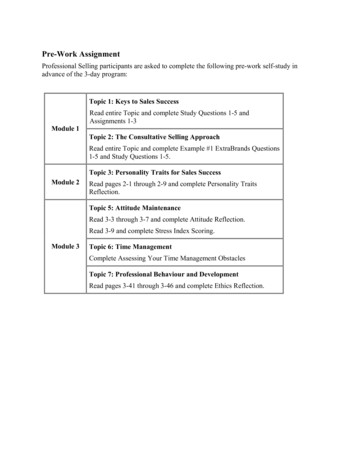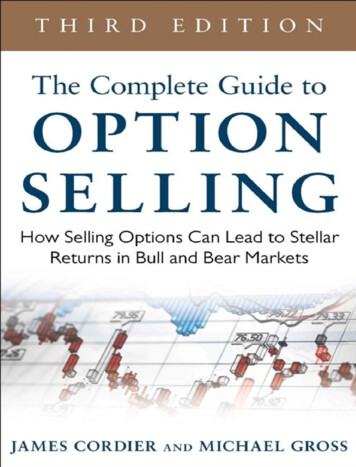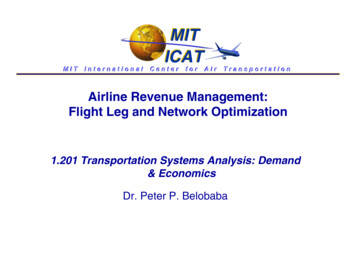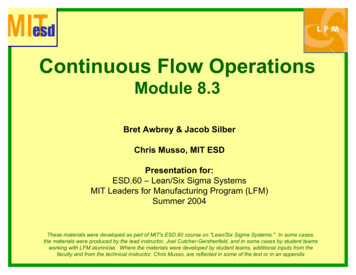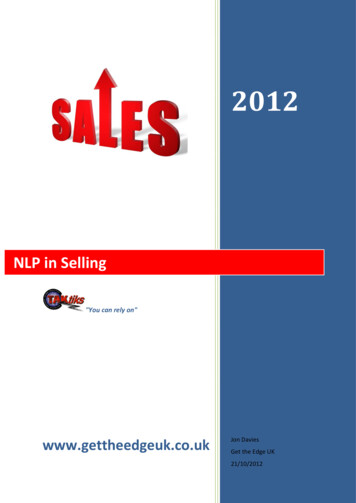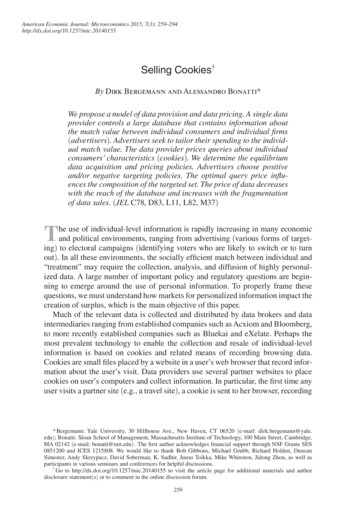
Transcription
American Economic Journal: Microeconomics 2015, 7(3): ling Cookies†By Dirk Bergemann and Alessandro Bonatti*We propose a model of data provision and data pricing. A single dataprovider controls a large database that contains information aboutthe match value between individual consumers and individual firms(advertisers). Advertisers seek to tailor their spending to the individual match value. The data provider prices queries about individualconsumers’ characteristics (cookies). We determine the equilibriumdata acquisition and pricing policies. Advertisers choose positiveand/or negative targeting policies. The optimal query price influences the composition of the targeted set. The price of data decreaseswith the reach of the database and increases with the fragmentationof data sales. (JEL C78, D83, L11, L82, M37)The use of individual-level information is rapidly increasing in many economicand political environments, ranging from advertising (various forms of targeting) to electoral campaigns (identifying voters who are likely to switch or to turnout). In all these environments, the socially efficient match between individual and“treatment” may require the collection, analysis, and diffusion of highly personalized data. A large number of important policy and regulatory questions are beginning to emerge around the use of personal information. To properly frame thesequestions, we must understand how markets for personalized information impact thecreation of surplus, which is the main objective of this paper.Much of the relevant data is collected and distributed by data brokers and dataintermediaries ranging from established companies such as Acxiom and Bloomberg,to more recently established companies such as Bluekai and eXelate. Perhaps themost prevalent technology to enable the collection and resale of individual-levelinformation is based on cookies and related means of recording browsing data.Cookies are small files placed by a website in a user’s web browser that record information about the user’s visit. Data providers use several partner websites to placecookies on user’s computers and collect information. In particular, the first time anyuser visits a partner site (e.g., a travel site), a cookie is sent to her browser, recording* Bergemann: Yale University, 30 Hillhouse Ave., New Haven, CT 06520 (e-mail: dirk.bergemann@yale.edu); Bonatti: Sloan School of Management, Massachusetts Institute of Technology, 100 Main Street, Cambridge,MA 02142 (e-mail: bonatti@mit.edu). The first author acknowledges financial support through NSF Grants SES0851200 and ICES 1215808. We would like to thank Bob Gibbons, Michael Grubb, Richard Holden, DuncanSimester, Andy Skrzypacz, David Soberman, K. Sudhir, Juuso Toikka, Mike Whinston, Jidong Zhou, as well asparticipants in various seminars and conferences for helpful discussions.†Go to http://dx.doi.org/10.1257/mic.20140155 to visit the article page for additional materials and authordisclosure statement(s) or to comment in the online discussion forum.259
260American Economic Journal: microeconomics august 2015any action taken on the site during that browsing session (e.g., searches for flights).1If the same user visits another partner website (e.g., an online retailer), the information contained in her cookie is updated to reflect the most recent browsing history.The data provider therefore maintains a detailed and up-to-date profile for eachuser, and compiles segments of consumer characteristics, based on each individual’sbrowsing behavior. The demand for such highly detailed, consumer-level information is almost entirely driven by advertisers, who wish to tailor their spending andtheir campaigns to the characteristics of each consumer, patient, or voter.The two distinguishing features of online markets for data are the following:(i) individual queries (as opposed to access to an entire database) are the actualproducts for sale,2 and (ii) linear pricing is predominantly used. In other words,advertisers specify which consumer segments and how many total users (“uniques”)they wish to acquire, and pay a price proportional to the number of users.3 Thesefeatures are prominent in the market for cookies, but are equally representative ofmany online and offline markets for personal information.In all these markets, a general picture emerges where an advertiser acquires verydetailed information about a segment of “targeted” consumers, and is rather uninformed about a larger “residual” set. This kind of information structure, togetherwith the new advertising opportunities, poses a number of economic questions.How is the advertisers’ willingness to pay for information determined? Which consumers should they target? How should a data provider price its third-party data?How does the structure of the market for data (e.g., competition among sellers, dataexclusivity) affect the equilibrium price of information? More specifically to onlineadvertising markets, what are the implications of data sales for the revenues of largepublishers of advertising space?In this paper, we explore the role of data providers on the price and allocation ofconsumer-level information. We provide a framework that addresses general questions about the market for data and contributes to our understanding of recent practices in online advertising. We develop a simple model of data pricing that capturesthe key trade-offs involved in selling the information encoded in third-party cookies.However, our model also applies more broadly to markets for consumer-level information, and it is suited to analyze several offline channels as well.The model considers heterogeneous consumers and firms. The (potential) surplusis given by a function that assigns a value to each realized match between a consumer and a firm (the match value function). The match values differ along a purelyhorizontal dimension, and may represent a market with differentiated products. Inorder to realize the potential match value, each firm must “invest” in contactingconsumers. An immediate interpretation of the investment decision is advertising1This type of cookie is known as third-party cookie because the domain installing it is different from theWebsite actually visited by the user. Over half of the sites examined in a study by the Wall Street Journal installed23 or more third-party cookies on visiting users’ computers (The Web’s New Gold Mine: Your Secrets, the WallStreet Journal, July 30, 2010).2We formally define a database and a query in the context of our model in Subsection IB.3Information based on third-party cookies can be priced in two ways: per stamp (CPS), where buyers pay forthe right to access information about an individual user, independent of the frequency of use of that data; and permille (CPM), where the price of the information is proportional to the number of advertising impressions shownusing that data. Most data providers give buyers a choice of the pricing criterion.
Vol. 7 No. 3 bergemann and bonatti: selling cookies261spending that generates contacts and eventually sales. We refer to the “advertisingtechnology” as the rate at which investment into contacts generates actual sales, andto a “cookie” as the information required to tailor advertising spending to specificconsumers.We maintain the two distinguishing features of selling cookies (individual queries and per-user “bit” pricing) as the main assumptions. These assumptions can bestated more precisely as follows: Individual queries are for sale. We allow advertisers to purchase information onindividual consumers. This enables advertisers to segment users into a targetedgroup that receives personalized levels of advertising, and a residual group thatreceives a uniform level of advertising (possibly zero). More formally, thismeans the information structures available to an advertiser are given by specificpartitions of the space of match values. Individual queries are priced separately. We restrict the data provider to set auniform unit price, so that the payment to the data provider is proportional tothe number of users (“cookies”) acquired.There exist, of course, other ways to sell information, though linear pricing ofcookies is a natural starting point. We address these variations in extensions of ourbaseline model. In particular, we explore alternative mechanisms for selling information, such as bundling and nonlinear pricing of data.In Section II, we characterize the advertisers’ demand for information for agiven price of data. We establish that advertisers purchase information on two convex sets of consumers, specifically those with the highest and lowest match values.Advertisers do not buy information about every consumer. Instead, they estimatethe match value within the residual group of consumers, and they exclude a convex set in order to minimize the prediction error. Under further conditions, thedata-buying policy takes the form of a single cutoff match value. However, advertisers may buy information about all users above the cutoff value (positive targeting) or below the cutoff value (negative targeting). Each of these data-buyingpolicies alleviates one potential source of advertising mismatch: wasteful spending on low-value matches, and insufficient intensity on high-value matches. Theoptimality of positive versus negative targeting depends on the advertising technology and on the distribution of match values, i.e., on properties of the completeinformation profit function alone.The advertising technology and the distribution of match values have implications for the cross-price externalities between the markets for data and advertising.In particular, a consistent pattern emerges linking the advertisers’ preferences forpositive versus negative targeting and the degree to which a publisher of advertisingspace benefits from the availability of consumer-level data.In Section III, we turn to the data provider’s pricing problem. We first examinethe subtle relationship between the price of cookies and the cost of advertising.The cost of advertising reduces both the payoff advertisers can obtain through better information, and their payoff if uninformed. The overall effect on the demandfor cookies and on the monopoly price is, in general, nonmonotone. In a leading
262American Economic Journal: microeconomics august 2015e xample, we establish that the price for cookies is single-peaked in the cost of advertising. This suggests which advertising market conditions may be more conducivefor the data provider.We then examine the role of market structure on the price of cookies. Surprisingly,concentrating data sales in the hands of a single data provider is not necessarilydetrimental to social welfare. Formally, we consider a continuum of informationproviders, each one selling one signal exclusively. We find that prices are higherunder data-sales fragmentation. The reason for this result is that exclusive sellersignore the negative externality that raising the price of information about one consumer imposes on the demand for information about all other consumers. A similarmechanism characterizes the effects of an incomplete database, sold by a singlefirm. In that case, the willingness to pay for information increases with the size ofthe database, but the monopoly price may, in fact, decrease. This is contrast with theeffect of a more accurate database.In Section IV, we enrich the set of pricing mechanisms available to the data provider. In particular, in a binary-action model, we introduce nonlinear pricing ofinformation structures. We show that the data provider can screen vertically heterogeneous advertisers by offering subsets of the database at a decreasing marginalprice. The optimal nonlinear price determines exclusivity restrictions on a set of“marginal” cookies: in particular, second-best distortions imply that some cookiesthat would be profitable for many advertisers are bought by only by a small subsetof high-value advertisers.The issue of optimally pricing information in a monopoly and in a competitive market has been addressed in the finance literature, starting with seminal contributionsby Admati and Pfleiderer (1986); Admati and Pfleiderer (1990); and Allen (1990),and more recently by García and Sangiorgi (2011). A different strand of the literaturehas examined the sale of information to competing parties. In particular, Sarvaryand Parker (1997) model information-sharing among competing consulting companies; Xiang and Sarvary (2013) study the interaction among providers of informationto competing clients; Iyer and Soberman (2000) analyze the sale of heterogeneoussignals, corresponding to valuable product modifications, to firms competing in adifferentiated-products duopoly; Taylor (2004) studies the sale of consumer lists thatfacilitate price discrimination based on purchase history; Calzolari and Pavan (2006)consider an agent who contracts sequentially with two principals, and allow the former to sell information to the latter about her relationship (contract offered, decisiontaken) with the agent. All of these earlier papers only allow for the complete sale ofinformation. In other words, they focus on signals that revealed (noisy) informationabout all realizations of a payoff-relevant random variable. The main difference withour paper’s approach is that we focus on “bit-pricing” of information, by allowing aseller to price each realization of a random variable separately.The literature on the optimal choice of information structures is rather recent.Bergemann and Pesendorfer (2007) consider the design of optimal informationstructures within the context of an optimal auction. There, the principal controlsthe design of both the information and the allocation rule. More recently, Kamenicaand Gentzkow (2011) consider the design of the information structure by the principal when the agent will take an independent action on the basis of the received
Vol. 7 No. 3 bergemann and bonatti: selling cookies263i nformation. In contrast to the persuasion literature, we endogenize the agent’sinformation cost by explicitly analyzing the monopoly pricing of information ratherthan directly choosing an information structure.In related contributions, Anton and Yao (2002); Hörner and Skrzypacz (2012);and Babaioff, Kleinberg, and Paes Leme (2012) derive the optimal mechanismfor selling information about a payoff-relevant state, in a principal-agent framework. Anton and Yao (2002) emphasize the role of partial disclosure; Hörner andSkrzypacz (2012) focus on the incentives to acquire information; and Babaioff,Kleinberg, and Paes Leme (2012) allow both the seller and the buyer to observeprivate signals. Finally, Hoffmann, Inderst, and Ottaviani (2014) consider targetedadvertising as selective disclosure of product information to consumers with limitedattention spans.The role of specific information structures in auctions, and their implication foronline advertising market design, are analyzed in recent work by Abraham et al.(2014); Celis et al. (forthcoming), and Syrgkanis, Kempe, and Tardos (2013). Allthree papers are motivated by asymmetries in bidders’ ability to access additionalinformation about the object for sale. Ghosh et al. (2012) study the revenue implications of cookie-matching from the point of view of an informed seller of advertisingspace, uncovering a trade-off between targeting and information leakage. In earlierwork, Bergemann and Bonatti (2011), we analyzed the impact that changes in theinformation structures, in particular the targeting ability, have on the competition foradvertising space.I. ModelA. Consumers, Advertisers, and MatchingWe consider a unit mass of uniformly distributed consumers (or “users”), i [0, 1] , and advertisers (or “firms”), j [0, 1] . Each consumer-advertiser pair (i, j) generates a (potential) match value for the advertiser j :(1) v : [0, 1] [0, 1] V, with v (i, j) V [ v , v ̅] ℝ .Advertiser j must take an action q i j 0 directed at consumer i to realize thepotential match value v (i, j) . We refer to q as the match intensity. We abstract fromthe details of the revenue-generating process associated to matching with intensity q . The complete-information profits of a firm generating a match of intensity q witha consumer of value v are given by(2) π (v, q) vq c · m (q) . The matching cost function m : ℝ ℝ is assumed to be increasing, continuously differentiable, and convex. In the context of advertising, q corresponds to theprobability of generating consumer i ’s awareness about firm j ’s product. Awareness
264American Economic Journal: microeconomics august 2015q is generated by buying an amount of advertising space m ( q) , which we assume canbe purchased at a unit price c 0 . If consumer i is made aware of the product, hegenerates a net present value to the firm equal to v( i, j) .B. Data ProviderInitially, the advertisers do not have information about the pair-specific matchvalues v (i, j) beyond the common prior distribution described below. By contrast,the monopolistic data provider has information relating each consumer to a set ofcharacteristics represented by the index i , and each advertiser to a set of characteristics represented by the index j . The database of the data provider is simply the mapping (1) relating the characteristics ( i, j) to a value of the match v (i, j) , essentiallya large matrix with a continuum of rows (representing consumers) and columns(representing firms).Advertisers can request information from the data provider about consumers withspecific characteristics i . Now, from the perspective of advertiser j, the only relevantaspect of the consumer’s characteristic i is the match value v ( i, j) . Thus, we refer tocookie v as the information necessary for advertiser j to identify all consumers witha realized match value v v (i, j) . Similarly, we refer to query v as the request byadvertiser j to identify all consumers in the database with characteristics i , such that v v (i, j) .4Advertisers purchase information from the data provider in order to target theirspending. For example, if advertiser j wishes to tailor his action q to all consumerswith value v , then he queries for the identity of all consumers with characteristics i ,such that v v (i, j) . More generally, each advertiser j can purchase informationabout any subset of consumers with match values v A j V . Thus, if advertiser j makes a query v (i.e., purchases the cookie v ), then the value v v (i, j) belongs tothe set A j , and the advertiser can target consumers with value v with a tailored levelof match intensity. For this reason, we refer to the sets Aj and Aj C as the targeted setand the residual set (or complementary set), respectively.We assume that the data about the individual consumer is sold at a constant linearprice p per cookie.5C. Distribution of Match ValuesThe (uniform) distribution over the consumer-firm pairs ( i, j) generates a distribution of values through the match value function (1). For every measurable subset A of values in V , the resulting measure μ is given by μ( A) {i, j [0, 1] v(i, j) A} di dj. 4A query v to the database thus requests the information contained in the cookie v, and in this sense we can usecookie and query as synonyms. To be precise, the cookie is the information technology that allows the database torecord the characteristics of consumer i and the query retrieves the information from the database.5This assumption reflects the pricing of data “per unique user” (also known as “cost per stamp”). It also matchesthe offline markets for data, where the price of mailing lists or lists of credit scores is related to the number of userrecords.
Vol. 7 No. 3 Data providersets price pbergemann and bonatti: selling cookiesNature drawsmatch value vAdvertiser j buysinformation about userswith match value v in AjIf v is in Aj ,advertiserlearns v265Advertiserchooses action qFigure 1. TimingLet the interval of values beginning with the lowest value be A v [ v , v] . Theassociated distribution function F : V [0, 1] is defined by F( v) μ ( Av ) . By extension, we define the conditional measure for every consumer i and everyfirm j by { μ i( A) j [0, 1] v(i, j) A} dj,and μj (A) {i [0, 1] v(i, j) A} di, and the associated conditional distribution functions Fi (v) and F j (v) . We assume thatthe resulting match values are identically distributed across consumer and acrossfirms, i.e., for all i , j , and v : Fi ( v) Fj ( v) F (v) . Thus, F ( v) represents the common prior distribution for each firm and each consumer about the match values. Thus, the price of the targeted set Aj is given by(3) p( Aj ) p · μ ( Aj ) . Prominent examples of distributions that satisfy our symmetry assumptioninclude: independently and identically distributed match values across consumer-firm pairs; and uniformly distributed firms and consumers around a unit-lengthcircle, where match values are a function of the distance i j . In other words,match values differ along a purely horizontal dimension. This assumption capturesthe idea that, even within an industry, the same consumer profile can represent a highmatch value to some firms and a low match value to others firms. This is clearly truefor consumers that differ in their geographical location, but applies more broadly aswell.6Figure 1, above, summarizes the timing of our model.We note that the present model does not explicitly describe the consumer’s problem and the resulting indirect utility. To the extent that information facilitates the6Consider the case of credit score data: major credit card companies are interested in reaching consumers withhigh credit-worthiness; banks that advertise consumer credit lines would like to target individuals with averagescores, who are cash-constraint, but unlikely to default; and subprime lenders, such as used car dealers, typicallycater to individuals with low or nonexisting credit scores, see Adams, Einav, and Levin (2009) for a description andmodel of subprime lending.
266American Economic Journal: microeconomics august 2015creation of valuable matches between consumers and advertisers, as a first approximation, the indirect utility of the consumer may be thought of as co-monotone withthe realized match value v . In fact, with the advertising application in mind, we mayview q as scaling the consumer’s willingness to pay directly, or as the amount ofadvertising effort exerted by the firm, which also enters the consumer’s utility function. Thus, the profit function in (2) is consistent with the informative, as well as thepersuasive and complementary views of advertising (see Bagwell 2007).A more elaborate analysis of the impact of information markets on consumersurplus and on the value of privacy would probably have to distinguish betweeninformation that facilitates the creation of surplus, which is focus of present paper,and information that impacts the distribution of surplus. For example, additionalinformation could improve the pricing power of the firm and shift surplus from theconsumer to the firm (as for example in Bergemann, Brooks, and Morris 2013).II. Demand for InformationThe value of information for each advertiser is determined by the incrementalprofits they could accrue by purchasing more cookies. Advertiser j is able to perfectly tailor his advertising spending to all consumers included in the targeted set A j . In particular, we denote the complete information demand for advertising space q ( v) and profit level π ( v) by [π (v, q) ] , q (v) arg max q ℝ π (v) π (v, q (v) ) . By contrast, for all consumers in the complement (or residual) set Aj C , advertiser j must form an expectation over v ( · , j) , and choose a constant level of q for all suchconsumers. Because the objective π( v, q) is linear in v , the optimal level of advertising q ( Aj C ) is given by q ( Aj C ) arg max E [π (v, q) v Aj C ] q (E[v v A j ]) . q ℝ We can represent each advertiser’s information acquisition problem as the choice ofa measurable subset A of the set of match values V : [ ( π (v, q (v) ) p) dF (v) C π (v, q ( AC ) ) dF (v) ] , (4) max A A A Vwhere, by symmetry, we can drop the index j for the advertiser.By including all consumers with match value v into the targeted set A, the advertiser can raise his gross profits from the uninformed choice to the informed choiceof q , albeit at the unit cost p per consumer. In problem (4), the total price paid by theadvertisers to the data provider is then proportional to the measure of the targeted
Vol. 7 No. 3 bergemann and bonatti: selling cookies267set, or p · μ (A) . Next, we characterize the properties of the optimal targeted set, asa function of the price of cookie p and of the cost of advertising c. We begin with asimple example.A. The Binary Action EnvironmentWe start with linear matching costs and uniformly distributed match values;we then generalize the model to continuous actions and general distributions.Formally, let F (v) v , with v [0, 1] and c · m (q) c · q , with q [0, 1] .The linear cost assumption is equivalent to considering a binary action environment, q {0, 1} , as the optimal policy will only take those two values.In this simplified version of the model, targeting is very coarse: under completeinformation, it is optimal to contact a consumer v (i.e., to choose q ( v) 1 ) if andonly if the match value v exceeds the unit cost of advertising c . Thus, the completeinformation profits are given by {v c, 0} . (5) π ( v) max Likewise, the optimal action on the residual set is given by q ( AC ) 1 E [v v AC ] c. As we show in Proposition 1, advertisers adopt one of two mutually exclusivestrategies to segment the consumer population: ( i) positive targeting consists ofbuying information on the highest-value consumers, contacting them and excludingeveryone else; ( ii) negative targeting consists of buying information on the lowestvalue consumers, avoiding them and contacting everyone else. That is, advertisers and a different constantchoose a constant action q {0, 1} on the targeted set Aaction on the residual set A C . The actions differ across the targeted and the residualset as information about consumer v has a positive value only if it affects the advertiser’s subsequent action.The choice of the optimal targeting strategy and the size of the targeted set naturally depend on the cost of contact c and on the price of information p . We denotethe optimal targeted set by A (c, p) . This set is defined by a threshold value v that v, v ] , or an upper interval [ v , v̅ ] , depending oneither determines a lower interval [ the optimality of either negative or positive targeting, respectively. The optimality ofa threshold strategy follows from the monotonicity of the profit in v and the binaryaction environment.We identify the size of the targeted set by considering the willingness to pay forthe marginal cookie under each targeting strategy. If the advertiser adopts positivetargeting, then he purchases information on all consumers up to the threshold v thatleaves him with nonnegative net utility, or v c p . Conversely, if the advertiseradopts negative targeting, then at the marginal cookie, the gain from avoiding thecontact, and thus saving c v , is just offset by the price p of the cookie, and thus v c p . Under either targeting strategy, the advertiser trades off the magnitude
268American Economic Journal: microeconomics august 2015of the error made on the residual set with the cost of acquiring additional information. Proposition 1 characterizes the optimal targeting strategy.Proposition 1 (Targeting Strategy): For all c, p 0 , the optimal targeted set A( c, p) is the interval of values v given by [0, max { c p, 0} ] if c 1/2; A (c, p) { [min {c p, 1} , 1] if c 1/2 .If the cost of advertising, i.e., the matching cost c , is particularly high, it is onlyprofitable to bear the costs of generating awareness through advertising for veryhigh-value customers, about which information is acquired from the data provider.Conversely, for low costs of advertising, all customers but the very low-value onesare profitable, about which information is purchased in order to exclude them fromadvertising.7Proposition 1 establishes that the residual and the targeted set are both connectedsets (intervals), and that advertisers do not buy information about every consumer.The binary environment illustrates some general features of optimal targeting andinformation policies. In particular, three implications of Proposition 1 extend togeneral settings: (i) the residual set is nonempty; (ii) advertisers do not necessarilybuy the cookies of high-value consumers; and (iii) the cost c of the advertising spaceguides their strategy. At the same time, the binary environment cannot easily captureseveral aspects of the model, including the following: the role of the distributionof match values (and of the relative size of the left and the right tail in particular);the role of precise tailoring and the need for more detailed information; the determinants of the advertisers’ optimal targeting strategy; and the effect of t
Selling Cookies† By Dirk Bergemann and Alessandro Bonatti* We propose a model of data provision and data pricing. A single data provider controls a large database that contains information about the match value between individual consumers and individual firms (advertisers). Advertisers s

